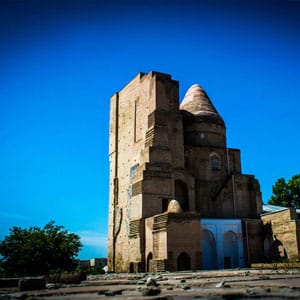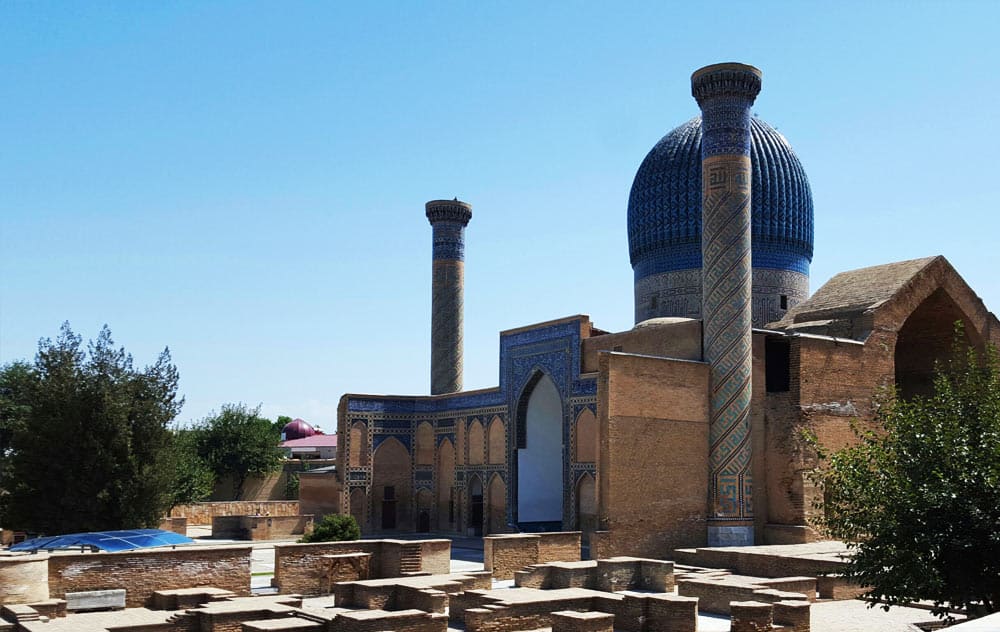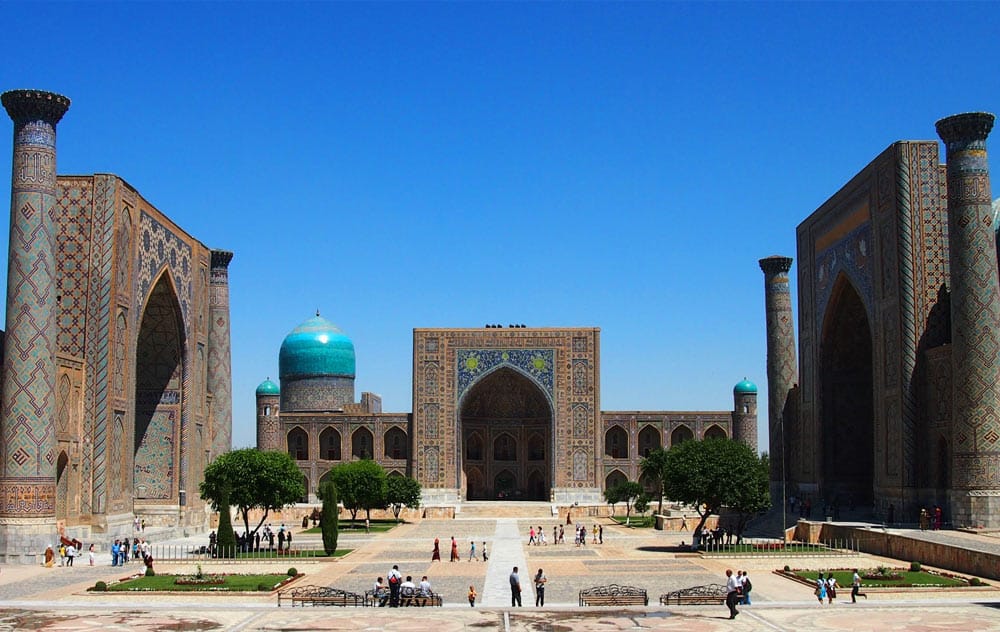Samarkand Travel Guide
Welcome to Samarkand, often hailed as the “Pearl of the East” and one of Central Asia’s most illustrious cities. Steeped in centuries of history, Samarkand served as a vibrant crossroads along the ancient Silk Road, connecting East and West. From its stunning Islamic architecture to its bustling bazaars and mouthwatering cuisine, this Uzbekistan city guide will walk you through the things to do in Samarkand, where to stay, and how to make the most of your journey—especially if it’s your first time.
Overview & History
A Jewel of the Silk Road
Samarkand’s history stretches back over 2,700 years, making it one of the oldest inhabited cities in Central Asia. Its strategic position along the Silk Road allowed it to blossom into a multicultural hub where merchants, scholars, and explorers congregated. Over the centuries, rulers like Alexander the Great, Genghis Khan, and the mighty Timur (Tamerlane) left their indelible marks on the city’s development, shaping it into a vibrant mosaic of architectural wonders and cultural traditions.
Historical Quote
“Samarkand is the mirror of the world.”
– A Persian saying that reflects the city’s status as a cosmopolitan center of art, science, and trade.
Key Historical Events & Architectural Heritage
- Conquest by Alexander the Great (329 BC): Helped bring Hellenistic influences to the region.
- Destruction by Genghis Khan (1220 AD): Although the Mongol invasion ravaged the city, Samarkand later rose to even greater prominence.
- Timurid Era (14th–15th Centuries): Under Timur’s rule, Samarkand experienced a golden age. Many of its most famous monuments, including the Registan ensemble, date from this period.
- Architectural Legacy: Samarkand boasts awe-inspiring madrasahs, mausoleums, and mosques adorned with lavish tilework, majestic domes, and intricate carvings.
Lesser-Known Fact: There’s a local legend that Timur aspired to make Samarkand’s monuments “touch the sky,” fueling the city’s architectural ambitions—apparent in the towering facades of its iconic buildings.
Must-Visit Samarkand Attractions
Samarkand’s landmarks speak to its storied past. Below are the top sights every traveler should include on their Samarkand travel guide itinerary.
Registan Square
Why Visit: Known as Samarkand’s most iconic landmark, the Registan is a trio of majestic madrasahs—Ulugh Beg, Sher-Dor, and Tilya-Kori—surrounding a grand public square.
Historical Insight:
- Ulugh Beg Madrasah (1417–1420): Commissioned by Timur’s grandson, an astronomer and mathematician who turned it into a world-renowned center of learning.
- Sher-Dor Madrasah (1619–1636): Famous for its bold mosaic of tigers (a rare motif in Islamic art).
- Tilya-Kori Madrasah (1646–1660): Notable for its lavish gold interior and dual function as a mosque and madrasah.
Visitor Tips: - Best Time to Visit: Early morning or late afternoon for softer light and fewer crowds.
- Unique Aspect: At night, the Registan is often illuminated, creating a magical photo opportunity.
Shah-i-Zinda Necropolis
Why Visit: This hillside avenue of mausoleums impresses with some of Central Asia’s finest tilework, reflecting a kaleidoscope of turquoise and cobalt.
Historical Insight:
- Legend holds that the complex grew around the grave of Kusam ibn Abbas, a cousin of the Prophet Muhammad.
- Timurid nobles built lavish tombs to be close to this sacred burial site.
Visitor Tips: - Golden Hour: Late afternoon light enhances the vibrant tiles.
- Photography Note: The narrow alley is crowded, so plan for early morning to avoid congestion.
Bibi-Khanym Mosque
Why Visit: Once one of the largest mosques in the Islamic world, Bibi-Khanym was commissioned by the conqueror Timur.
Historical Insight:
- Built around the late 14th century to showcase Timur’s power.
- A local legend claims Timur’s wife supervised its construction while he was away, giving rise to romantic tales about the mosque’s origin.
Visitor Tips: - Best Time to Visit: Morning for fewer tour groups.
- Unique Aspect: Adjacent to Siab Bazaar, a perfect spot to experience local life and sample fresh produce.
Gur-e-Amir Mausoleum
Why Visit: The final resting place of Timur, Gur-e-Amir features an iconic azure dome and opulent interior design.
Historical Insight:
- Timurid princes like Ulugh Beg also lie here.
- Known for its ribbed dome, a precursor to future Mughal architecture in India.
Visitor Tips: - Lighting: Evening illumination highlights the dome’s intricate patterns.
- Photography Tip: Capture the reflection of the dome on a nearby water surface if there’s been recent rainfall.
Samarkand Photography Tips
For travelers seeking the perfect shot, here are practical Samarkand photography tips:
- Golden Hours (Sunrise & Sunset)
- Registan: Soft morning light illuminates the tilework gently.
- Bibi-Khanym: Sunset’s warm hues can make the massive dome glow.
- Ideal Angles
- Wide-Angle Lens: To capture the towering portals and spacious courtyards.
- Close-Ups: Highlight mosaic details, Arabic calligraphy, and unique architectural motifs.
- Recommended Equipment
- Tripod: Helpful for low-light scenarios (e.g., evening shots of the Registan).
- Polarizing Filter: Cuts glare and enhances blue skies against turquoise domes.
- Make Use of Shadows
- Many monuments cast intricate shadows on surrounding tiles—experiment with these for dramatic compositions.
Local Cuisine & Dining
No Samarkand travel guide is complete without sampling the city’s mouthwatering cuisine:
- Traditional Uzbek Dishes
- Plov (Pilaf): Uzbekistan’s national dish, typically made with rice, lamb, carrots, onions, and spices.
- Shashlik (Skewers): Grilled cubes of marinated meat, often served with fresh onions.
- Lagman: A noodle soup packed with vegetables and aromatic spices.
- Where to Eat
- Siab Bazaar: Try fresh local bread (non) and dried fruits; perfect for a quick, budget-friendly bite.
- Local Teahouses (Choyxona): Enjoy a pot of green tea with samsa (baked pastries stuffed with meat or vegetables).
- Fine Dining: Several restaurants near the Registan offer upscale Uzbek-European fusion menus with stunning terrace views of the monuments.
Accommodations & Transportation
Where to Stay
- Budget Options: Small guesthouses or hostels in the old town offer cost-effective stays and authentic Uzbek hospitality.
- Mid-Range Hotels: Modern hotels near the city center, often featuring comfortable rooms, Wi-Fi, and helpful multilingual staff.
- Luxury Hotels: Upscale establishments boasting panoramic views of iconic landmarks (some rooftops overlook the Registan) and premium amenities.
Getting Around
- Airport to City: Samarkand International Airport is about 15–20 minutes by taxi to the city center.
- Trains: The Afrosiyob high-speed rail links Tashkent and Samarkand in roughly 2 hours.
- Local Transport:
- Taxis: Inexpensive and widely available.
- Buses/Marshrutkas (Shared Minibuses): Cover most routes; fares are very low, though schedules can be irregular.
- On Foot: Many main attractions are clustered in the historical center, making it easy to explore by walking.
Practical Tips for First-Time Visitors
- Cultural Etiquette
- Dress modestly, especially when entering religious sites (cover shoulders and knees).
- Always remove shoes before entering mosques and mausoleums.
- Best Times to Visit
- Spring (March–May): Mild weather, blooming flowers, fewer tourists.
- Autumn (September–November): Comfortable temperatures, clear skies.
- Currency & Payments
- Uzbek Sum (UZS) is the national currency.
- Carry small denominations—credit card use is growing but still limited in many places.
- Safety & Health
- Samarkand is generally safe; remain aware of pickpockets in crowded spots.
- Stay hydrated, particularly if you’re visiting in the hot summer months.
Interesting Sights & Off-the-Beaten-Path Attractions
Beyond the main Samarkand attractions, there are additional things to do in Samarkand that can enrich your travel experience:
- Ulugh Beg Observatory
- Built by the famed astronomer Ulugh Beg, this 15th-century observatory was once the most advanced in the Islamic world.
- Entry Fee & Hours: Usually opens around 9 AM; affordable ticket prices include a small museum exhibit.
- Khazrat-Khizr Mosque
- One of the city’s oldest mosques, perched on a hill near the Bibi-Khanym Mosque.
- Visitor Note: The panoramic view of Samarkand’s old quarter is a hidden gem for photographers.
- Rukhabad Mausoleum
- A simpler, more intimate Timurid-era structure, believed to hold sacred relics and the tomb of a revered mystic.
- Tip: Great contrast to the grandeur of Gur-e-Amir or Shah-i-Zinda, showcasing Sufi spirituality’s influence on the region.
- Siab Bazaar
- While not exactly off the main tourist path, the bazaar’s daily hustle—where locals buy fresh produce, spices, and bread—offers a window into Samarkand’s modern life.
- Nearby Amenities: The adjacent area is full of street vendors selling traditional sweets, dried fruits, and souvenirs.
Conclusion
Brimming with architectural grandeur, historic depth, and vibrant cultural traditions, Samarkand remains a must-see destination for anyone exploring Uzbekistan. This first-time visitor tips guide covers the highlights of the city, but part of Samarkand’s charm lies in its hidden corners—quiet teahouses, local neighborhood bazaars, and lesser-known monuments waiting to be discovered.
From sunrise at the Registan to sunset at Shah-i-Zinda, your camera will capture a tapestry of ornate tilework, gleaming domes, and lively street scenes. Treat your palate to Uzbek cuisine, immerse yourself in centuries-old history, and soak up the welcoming spirit of this timeless Silk Road gem. Armed with these Samarkand photography tips and cultural insights, you’ll be ready to plan an enriching trip through one of Central Asia’s most captivating cities.
Tours from and around Samarkand






